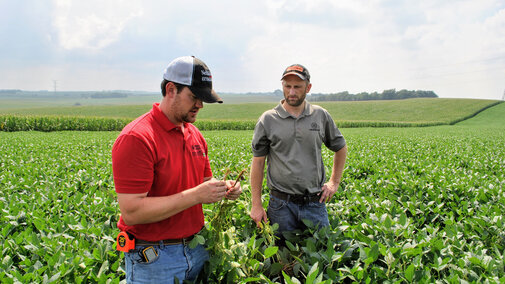Are you looking for management practices that will increase your soybean yields? An on-farm research study has been evaluating three practices that may contribute to increased soybean yields. In 2019 and 2020, a total of 10 studies were conducted by Nebraska farmers working with the Nebraska On-Farm Research Network. The project is part of a larger, multi-state effort involving the University of Wisconsin, Ohio State University, Michigan State University, Iowa State University, North Dakota State University, University of Minnesota and University of Nebraska.
The practices evaluated vary by state; in Nebraska, the studies examined planting date, seeding rate and the use of foliar fungicides and insecticides. The practices evaluated a “baseline” treatment, which was considered to be the conventional, standard practice, and an “improved” treatment, which utilized practices that survey data found to be associated with higher yields.
The baseline treatment consisted of a later planting date, higher seeding rate, and no foliar fungicide and insecticide treatment.
The improved treatment consisted of an earlier planting date, lower seeding rate and foliar fungicide and insecticide treatment.
Brothers Larry and Lonnie Schafer, who farm corn and soybeans near Tobias, Nebraska, are owners of one of the operations that evaluated these practices in both 2019 and 2020. For Lonnie, the interest in participating in this study stemmed from his desire to learn more about soybean planting date and seeding rates.
“We’ve always been curious about soybean planting dates and populations and this seemed like a good fit,” Lonnie explained.

Larry noted that the project did take some extra time to implement, but that his local extension educator was available to help with plot design and data collection and that agriculture technologies made it easier to conduct the study.
The results of the first year of the study were promising. Across four sites, the improved treatment resulted in an average 8 bu/ac yield increase and $46/ac profit increase compared to the baseline treatment.
The 2021 growing season will be the final year for the study and we are still looking for more farmers to participate. Are you interested in learning how these management practices may impact your soybean yield and profitability? Read on for more details and learn how you can get involved.
STUDY DETAILS
Where Will the Trials Be Located?
All research sites will need to be located in the shaded regions on the map in Figure 1 (any color).
What Does the Research Plan Look Like?
There will be four replications of the two treatments (baseline and improved). The baseline treatment will look at late-planted soybeans (after May 15), soybean seeding rates around 160,000 seeds/ac, and no foliar fungicide or insecticide treatments. The improved treatment will look at early-planted soybeans (late April/early May) at a seeding rate around 130,000 seeds/ac, with a foliar fungicide and insecticide treatment around the R3 stage (beginning of pod setting).

Due to grower interest, we have added an option to include the following study (below) as an OPTIONAL ADDITION, next to the above trial.

What Equipment and Technology Do I Need to Have?
Because you will be planting some strips early and skipping some passes to come back and plant later (for the late planted treatment), the study will be easiest if you have auto-guidance on your planter and the ability to generate as-planted maps. Similarly, the ability to generate as-applied data from your fungicide and insecticide application will be helpful but not mandatory. Harvest data may be obtained using a well-calibrated yield monitor or weigh wagon. You will be required to provide all crop inputs (seed, fungicide, insecticide, etc.).
Will I Be Monetarily Compensated?
Yes, monetary compensation is available for this project, up to 20 growers.
What Kind of Assistance Will I Receive?
We will assist with the specifics of your plot layout (adjustments for your equipment widths and operation), assist with flagging and GPS locating of treatment strips, take stand counts on the fields, provide a soil test and seed quality results from the samples taken from your field.
What Kind of Fields Are You Looking For?
We prefer fields that are no-till or reduced till. Fields can be irrigated or non-irrigated, but should not have tile drainage.
Should My Soybeans Be Treated?
Yes, please use treated seed for this study.
How Many Trials Will Be Conducted?
A total of 20 research studies will be completed in 2021.
How Will the Data Be Used?
The results of these studies will be shared at on-farm research meetings, through extension publications and other research publications. To protect your anonymity, your name will not be connected to your research project in published materials.
How Do I Get Involved?
Contact Laura Thompson at 402-245-2224 or your local cropping systems extension educator.

